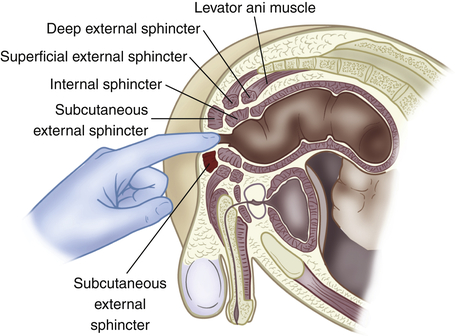Anus, Rectum, and Prostate
Examination
Technique
Findings
Wear gloves on both hands
Inspect and palpate sacrococcygeal and perianal area
EXPECTED: Smooth and uninterrupted.
UNEXPECTED: Lumps, rashes, tenderness, inflammation, excoriation, pilonidal dimpling, or tufts of hair.
Inspect anus
Spread patient’s buttocks.
Examine, using penlight or lamp if needed, with patient relaxed, as well as with patient bearing down.
EXPECTED: Skin coarser and darker than on buttocks.
UNEXPECTED: Skin lesions, skin tags or warts, external or internal hemorrhoids, fissures and fistulas, rectal prolapse, or polyps.
Inspect, palpate, assess sphincter tone
Put water-soluble lubricant on index or middle finger; press pad against anal opening, and ask patient to bear down to relax external sphincter. As relaxation occurs, slip tip of finger into anal canal, as shown in figure below. (Assure patient that although he or she may feel the urgency of a bowel movement, it will not occur.) Ask patient to tighten external sphincter around finger.
EXPECTED: Even sphincter tightening.
UNEXPECTED: Patient discomfort. Lax or extremely tight sphincter, tenderness.
Palpate muscular anal ring
Rotate finger.
EXPECTED: Smooth, even with consistent pressure exerted.
UNEXPECTED: Nodules or other irregularities.
Palpate lateral and posterior rectal walls
Insert finger farther and rotate to palpate lateral, then posterior, rectal walls. If helpful, perform bidigital palpation with thumb and finger by lightly pressing thumb against perianal tissue and bringing finger toward thumb.
EXPECTED: Smooth, even, uninterrupted.
UNEXPECTED: Nodules, masses, polyps, tenderness, or irregularities. (Internal hemorrhoids not ordinarily felt unless thrombosed.)

Males: Palpate posterior surface of prostate gland through anterior rectal wall
Rotate finger and palpate anterior rectal wall and posterior surface of prostate gland. Alert patient that he may feel urge to urinate but will not.
EXPECTED: Smooth, even, uninterrupted.
UNEXPECTED: Nodules, masses, polyps, tenderness, or irregularities.
![]()
Stay updated, free articles. Join our Telegram channel

Full access? Get Clinical Tree

 Get Clinical Tree app for offline access
Get Clinical Tree app for offline access

Anus, Rectum, and Prostate
Get Clinical Tree app for offline access